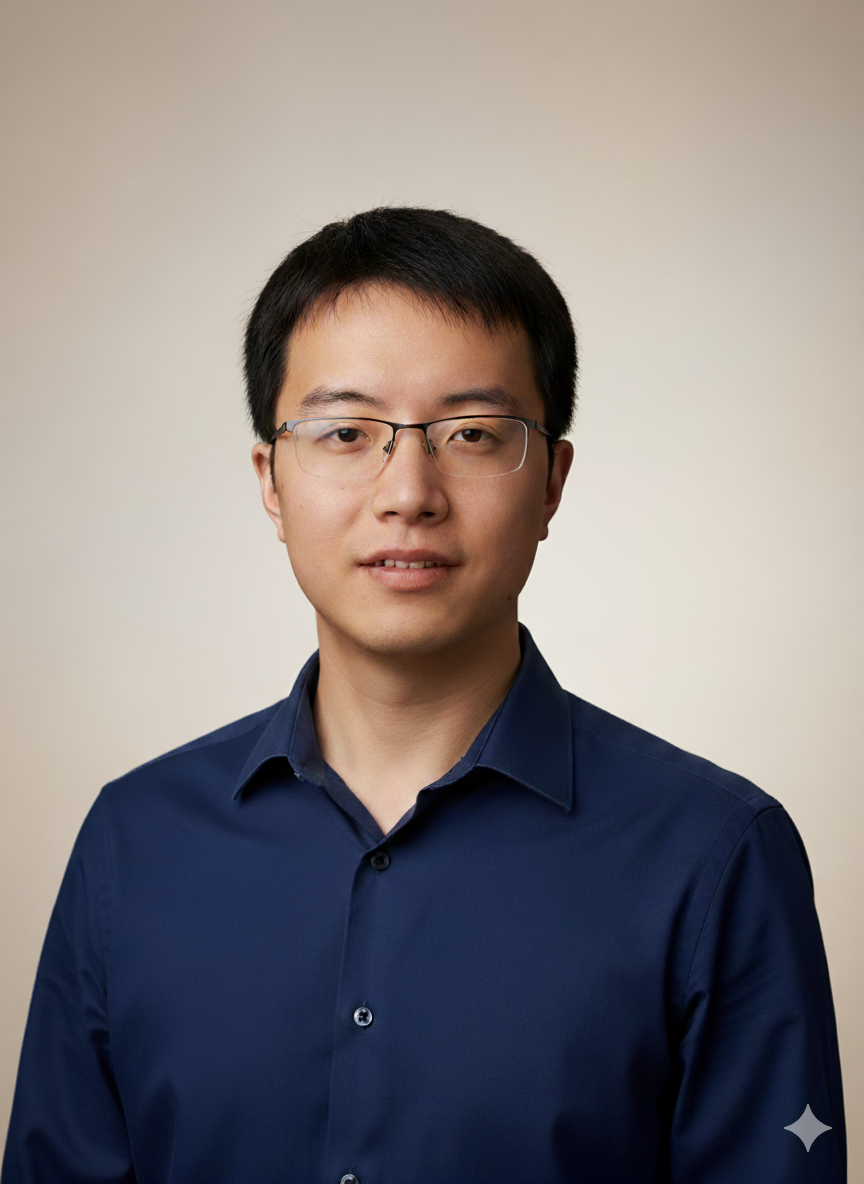Research
Wen Li is a Benjamin Ball Freud Merit Scholar, MRS Gold award winner, and PhD candidate in the Department of Chemistry at the University of Chicago, advised by Prof. Bozhi Tian. His research is at the nexus of bioelectronics, materials science, and human-computer interaction (HCI), envisioning a future where chemical, electrical and physical stimulation can be seamlessly integrated into our lives to enhance human capabilities and well-being. He envisions a world where a new generation of interfaces can (1) treat diseases and improve healthcare, (2) actively regulate human perception — altering sensory experiences like touch, smell, taste and thermal. A central part of this vision is to enable truly immersive virtual interactions, where a virtual handshake in a digital space could be felt with real warmth, texture, and force through an external device.
During his PhD, Wen focused on therapeutic gas delivery to treat pressure ulcer, also called bedsore. Therapeutic gasous drugs such as hydrogen and oxygen are difficult to generate, store and sustainably deliver to localized wounded tissue. Wen overcame this challenge by proposing, for the first time, using hydrogels as the electrochemical cells to trap therapeutic hydrogen gas generated via hydrogen evolution reaction (HER), achieving a prolonged and sustained gasous drug delivery. And now he is developing smart electronic mattress to further advance the treatment of bedsore.
Beyond healthcare, Wen is actively diving into Human Computer Interaction, where he is working with Prof. Pedro Lopes from Computer Science department at UChicago to investigate haptics. By borrowing parts of human body as input/output hardware, Wen is looking to develop new wearable devices to change human perception through controlled delivery of chemical stimulants or electrical stimulation.
Wen has published work in top research journals, such as Nature, Nature Nanotechnology, Nature Sustainability, Nature Chemical Engineering, Matter, etc. He published his leading author paper on Nature Chemical Engineering, CCS Chemistry and Langmuir. Beyond research, Wen is interested with entrepreneurship where he co-founded H-Pad with his undergraduate mentee Brennan Lee, and won $5,000 seed funding from The University of Chicago College New Venture Challenge(CNVC). Wen won 2025 Benjamin Ball Freud Merit Scholarship from UChicago Chemistry department and 2024 Outstanding Intern Award (3 out of 30-40 people) from Futurewei Technologies, Inc.
Outside the lab, Wen enjoys music. He plays piano and serves as bass singer at UChrous at UChicago. Check our performance here. Besides, he enjoys climbing, cycling, and playing Go.
News
December 5, 2025, Wen received both Material Research Society Graduate Student Gold Award and Best Poster Award in 2025 MRS Fall Meeting! It is very rare for one student to receive both Gold award and Best Poster at the same time in MRS.
October 24, 2025, Wen has been selected as a Graduate Student Award Finalist for the 2025 MRS Fall Meeting. He is the only person at UChicago this year in 2025 fall MRS Graduate Student Award Finalist. He will compete for Gold award on December 2 in Boston, MA!
August 15, 2025, Wen’s Nature Chemical Engineering paper is now online. As of September 22, 2025, Nature Chemical Engineering published 25 papers in the year of 2025. And Wen’s paper is one of them.
June 6, 2025, Wen receives Benjamin Ball Freud Merit Scholarship from UChicago Chemistry department.
May 21, 2025, Wen’s Nature Chemical Engineering paper on Hydrogen Evolution and Dynamics in Hydrogel Electrochemical Cells for Ischemia-Reperfusion therapy has been accepted in principle.
May 12, 2025, Wen is nominated for Schmidt Science Fellows 2026.
More News can be found here.
Key Publication
Nature and Nature research journals are highly prestigious journals for people who study engineering, fundamental science and applied science. They are fully peer-reviewed and usually have an acceptance rate below 5%. As Wen is diving into HCI and computer science, he will publish on ACM CHI and UIST conference in the future, which are also fully peer-reviewed and have an acceptance rate of 20-25%.
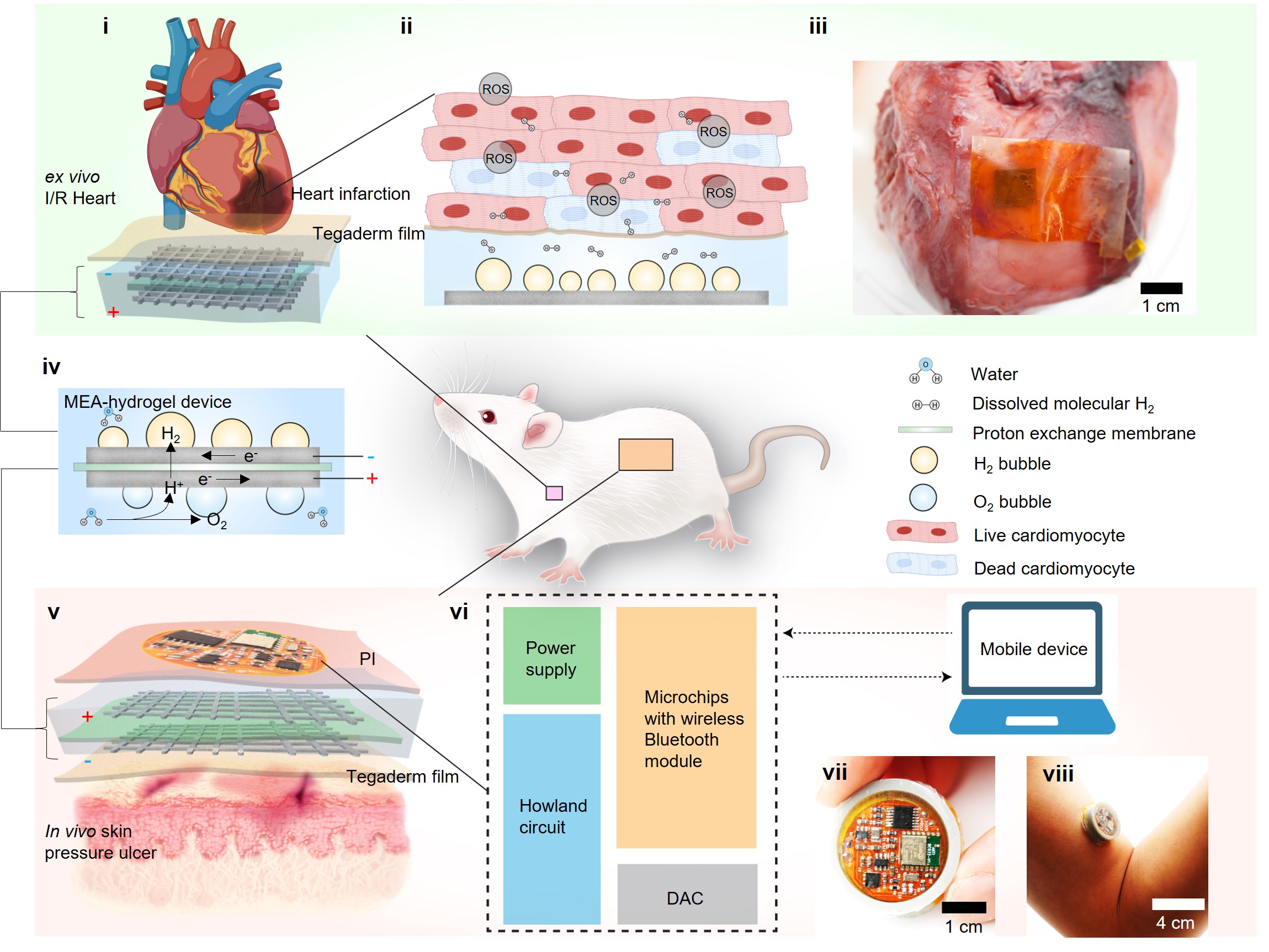
Nature Chemical Engineering 2025
Hydrogen Evolution and Dynamics in Hydrogel Electrochemical Cells for Ischemia-Reperfusion therapy
Wen Li, Jing Zhang, et al., B Tian
Molecular hydrogen (H2) protects organs from reactive oxygen species (ROS) damage associated with ischemia-reperfusion (I/R) injury and inflammation. Existing H2 delivery methods, such as gas inhalation and hydrogen-enriched water consumption, lack precision, targeting the entire body and experiencing substantial leakage during administration. Here, we engineer a wireless and portable hydrogel electrochemical cell, that enables on-demand H2 production via hydrogen evolution reaction (HER). The system enables H2 controlled generation, localized storage, and sustained diffusion to the tissue-device interface, with controllability and sustainability unattainable with current methods. We conduct the first thorough study of H2 evolution and dynamics in a pure hydrogel electrolyte system, evaluating the influence of hydrogel polymer composition on HER kinetics, gas morphologies, and gas storage. We validate its protective effects against ROS 1) in vitro with cardiomyocytes and keratinocytes, 2) ex vivo in an I/R heart model, and 3) in vivo in a skin I/R pressure ulcer model. These findings demonstrate the potential of hydrogel electrochemical cell design for efficient and sustainable H2 delivery in I/R therapy, which could be broadly applied in other gas-based therapies and drug delivery research.
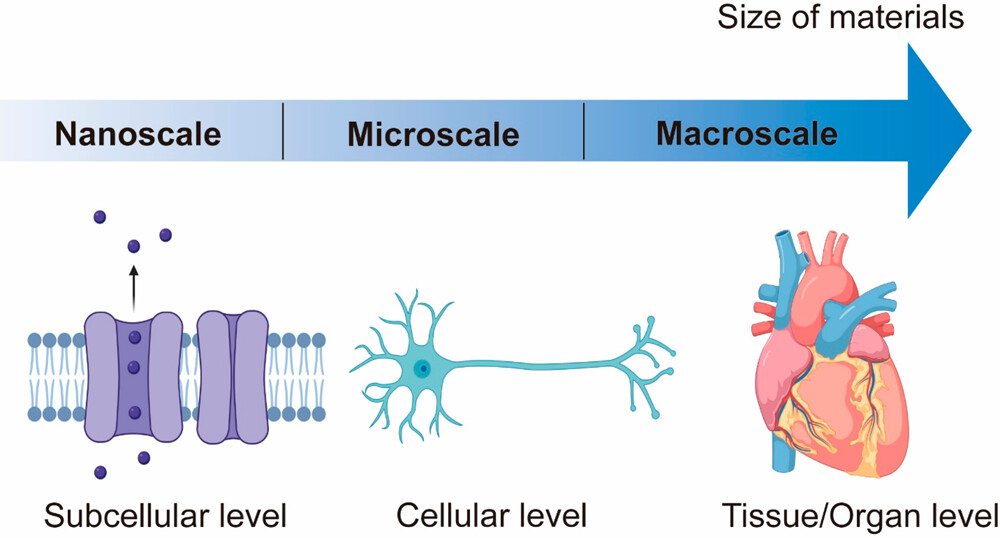
Langmuir 2023
Perspectives on Multiscale Colloid-Based Materials for Biomedical Applications
Wen Li, Judah Huberman-Shlaes, B Tian
Colloid-based materials with tunable biophysical and chemical properties have demonstrated significant potential in a wide range of biomedical applications. The ability to manipulate these properties across various size scales, encompassing nano-, micro-, and macrodomains, is essential to enhancing current biomedical technologies and facilitating the development of novel applications. Focusing on material design, we explore various synthetic colloid-based materials at the nano- and microscales and investigate their correlation with biological systems. Furthermore, we examine the utilization of the self-assembly of colloids to construct monolithic and macroscopic materials suitable for biointerfaces. By probing the potential of spatial imaging and localized drug delivery, enhanced functionality, and colloidal manipulation, we highlight emerging opportunities that could significantly advance the field of colloid-based materials in biomedical applications.
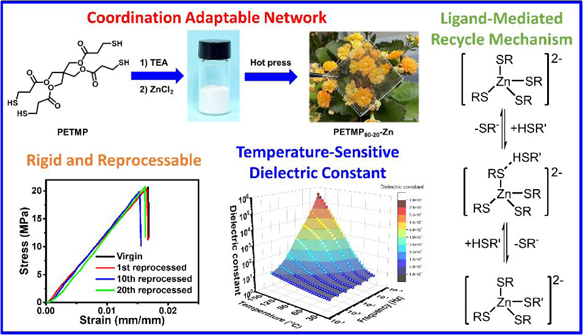
CCS Chemistry 2022
Wen Li, Hong-Qin Wang, Wen-Tong Gao, et al., Cheng-Hui Li
The investigation of covalent adaptable networks (CANs) is expanding rapidly due to the growing demand for sustainable materials, as CANs show thermoset-like behavior and yet can be reprocessed, recycled, and healed. However, most of the CANs reported so far have a trade-off between mechanical strength and reversible properties and often show performance reduction after reprocessing and/or recycling. Herein, we designed and synthesized a coordination adaptable network (CoAN) by crosslinking low-molecular-weight monomers with abundant coordination bonds. Owning to its excellent variable-stiffness property, leading to high stiffness at ambient conditions and low viscosity at elevated temperature, the as-prepared CoAN showed high mechanical rigidity but could be reprocessed rapidly and recycled at mild conditions. After reprocessing or recycling, the mechanical properties of the samples showed no performance reduction, compared with a pristine sample. Density functional theory calculations showed that free thiol ligands played a key role in reducing the activation energy for bond exchange. When used as binders for composites, the embedded carbon fibers could be recycled rapidly and still maintain the original microstructure. The material also showed temperature-sensitive dielectric and conductive properties due to the release of metal ions upon heating. Overall, such performances are superior among the CANs reported previously.
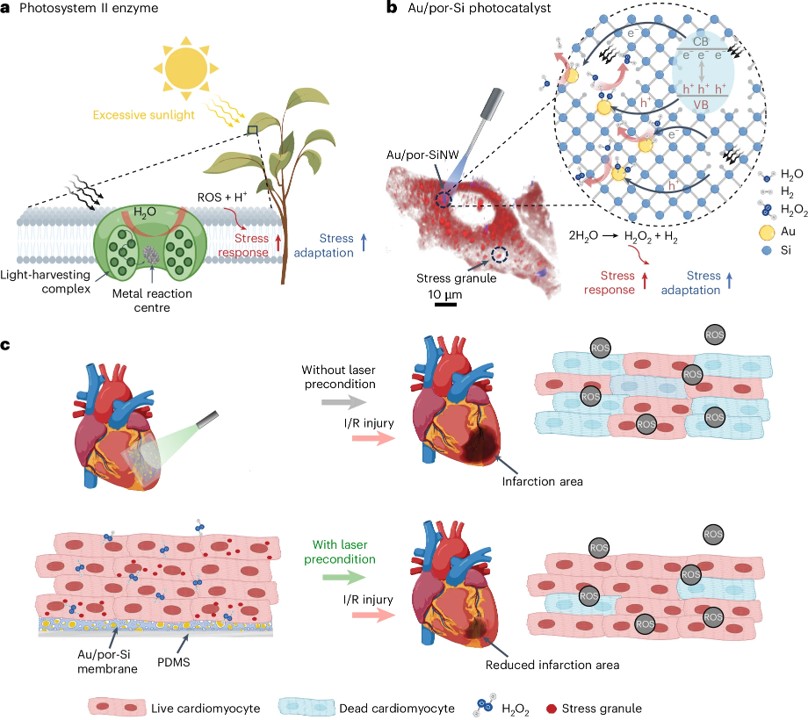
Nature Nanotechnology 2025
Gold-modified nanoporous silicon for photoelectrochemical regulation of intracellular condensates
Jing Zhang, Pengju Li, Jiping Yue, Lingyuan Meng, Wen Li, et al., Bozhi Tian
Nano-enabled catalysis at the interface of metals and semiconductors has found numerous applications, but its role in mediating cellular responses is still largely unexplored. Here we explore the territory by examining the once elusive mechanism through which a nanoporous silicon-based photocatalyst facilitates the two-electron oxidation of water to generate hydrogen peroxide under physiological conditions. We achieve precise modulation of intracellular stress granule formation by the controlled photoelectrochemical production of hydrogen peroxide in the extracellular environment, thereby enhancing cellular resilience to significant oxidative stress. This photoelectrochemical strategy has been evaluated for its efficacy in treating myocardial ischaemia–reperfusion injury in an ex vivo rodent model. Our data suggest that a pretreatment regimen involving photoelectrochemical generation of hydrogen peroxide at mild concentrations mitigates myocardial ischaemia–reperfusion-induced functional decline and infarction. These findings suggest a viable wireless therapeutic intervention for managing ischaemic disease and highlight the biomedical potential of nanostructured semiconductor-based catalytic devices.
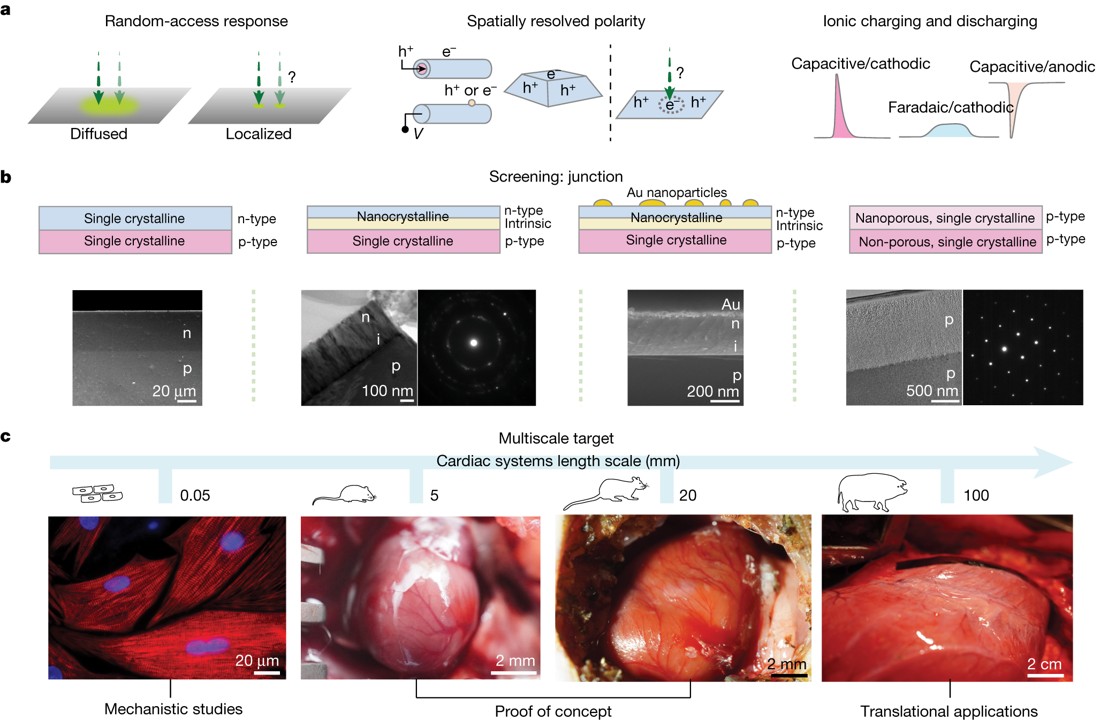
Nature 2024
Monolithic silicon for high spatiotemporal translational photostimulation
Pengju Li, Jing Zhang, Hidenori Hayashi, Jiping Yue, Wen Li, et al., Bozhi Tian
Electrode-based electrical stimulation underpins several clinical bioelectronic devices, including deep-brain stimulators1,2 and cardiac pacemakers3. However, leadless multisite stimulation is constrained by the technical difficulties and spatial-access limitations of electrode arrays. Optogenetics offers optically controlled random access with high spatiotemporal capabilities, but clinical translation poses challenges4,5,6. Here we show tunable spatiotemporal photostimulation of cardiac systems using a non-genetic platform based on semiconductor-enabled biomodulation interfaces. Through spatiotemporal profiling of photoelectrochemical currents, we assess the magnitude, precision, accuracy and resolution of photostimulation in four leadless silicon-based monolithic photoelectrochemical devices. We demonstrate the optoelectronic capabilities of the devices through optical overdrive pacing of cultured cardiomyocytes (CMs) targeting several regions and spatial extents, isolated rat hearts in a Langendorff apparatus, in vivo rat hearts in an ischaemia model and an in vivo mouse heart model with transthoracic optical pacing. We also perform the first, to our knowledge, optical override pacing and multisite pacing of a pig heart in vivo. Our systems are readily adaptable for minimally invasive clinical procedures using our custom endoscopic delivery device, with which we demonstrate closed-thoracic operations and endoscopic optical stimulation. Our results indicate the clinical potential of the leadless, lightweight and multisite photostimulation platform as a pacemaker in cardiac resynchronization therapy (CRT), in which lead-placement complications are common.
More papers can be found in google scholar.
Academic and Community Service
Peer Review Since May 2024, Wen serves as peer reviewer for ACS Nano and Device for American Chemical Society and Cell Press.
Entrepreneurship In 2024, Wen co-found H-Pad and serves as CTO of the company. he developed a medical device to treat bedsore and demonstrate its effectiveness in preclinical test. His team is one of 15 teams out of ~70 that entered CNVC phase II and won $5000 seed funding.
Chemistry Student Union Wen served as team leader in academic service department in Chemistry Student Union at Nanjing University. He held 5+ academic discussion seminars and held 2+ final exam review seminars to help students review for university chemistry courses. He won the Exceptional Team Leader in Academic Service Department and the Exceptional Freshman Mentor and Friend awards.
Teaching Assistant From 2021 to 2022, Wen TAed three classes: Organic Chemistry, Physical Chemistry experiment and Chemical Kinetics. Developed and delivered recitation classes once a week, supervised over 30 students in teaching laboratories and writing laboratory reports, and held weekly office hours.
